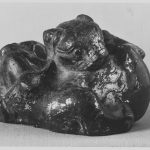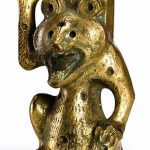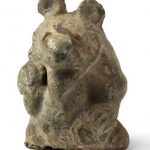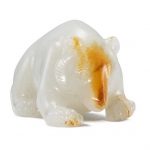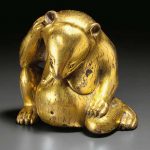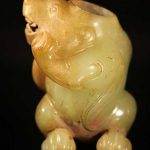Han Dynasty Bears. The Han dynasty was the second imperial dynasty of China (206 BC–220 AD), preceded by the Qin dynasty (221–206 BC) and succeeded by the Three Kingdoms period (220–280 AD). Spanning over four centuries, the Han period is considered a golden age in Chinese history. To this day, China’s majority ethnic group refers to themselves as the “Han Chinese” (Han Zu) and the Chinese script is referred to as “Han characters”. It was founded by the rebel leader Liu Bang, known posthumously as Emperor Gaozu of Han, and briefly interrupted by the Xin dynasty (9–23 AD) of the former regent Wang Mang. This interregnum separates the Han dynasty into two periods: the Western Han or Former Han (206 BC – 9 AD) and the Eastern Han or Later Han (25–220 AD).
Below are some examples of bear objects made during the Eastern and Western Han Dynasties
Mat Weight in the form of a Bear and Tiger in Combat ca. 2nd–1st century B.C.Western Han dynasty (206 B.C.–A.D. 9)
Reference: The Metropolitan Museum of Art
A GILT-BRONZE BEAR-FORM SUPPORT HAN DYNASTY hollow-cast in a half-kneeling position with the right fore paw raised above the head and the jaw open, the body finely incised with fur markings, with a D-shaped aperture in the top of the head and a circular opening in the base, Japanese wood box Quantity: 2 8.6cm., 3 3/8 in.
Sold for 15,000 GBP at Sotheby’s in 2015
Figure of a bear, red earthenware with iridescent green lead glaze; China, Eastern Han dynasty, 760-220 AD
Reference: © Victoria and Albert Museum
An exceedingly rare and important white and russet jade carving of a bear Western Han Dynasty Powerfully carved in movement, with the right foreleg extended forward, the head slightly tilted to the left, the round eyes gazing forward flanking the nose with small indentations for nostrils, the wide head with incised lines along the edges delineating the fur, the forehead with a central line below the raised ears, the rounded body and spine extending to the short tail with very fine incised lines on either side, the haunches well rounded and extending to the muscular legs and clawed feet, with one tucked underneath, the paws marked by circles, the fur along the belly denoted by two crescent incised lines, the stone of even white tone with russet along the nose and further minor inclusions, box. 5.7cm (2 5/16in) long (2).
Sold for HK$ 6,700,000 (£ 663,229) inc. premium at Bonham’s in 2018
A SUPERB GILT-BRONZE FIGURE OF A SEATED BEAR CHINA, WESTERN HAN DYNASTY (206 BC-AD 8) The seated figure shown scratching its right ear, with head lowered and mouth open to show the tongue lolling to one side, the fleshy body finely incised with wavy lines suggesting fur, and with finer, more closely arranged lines defining the brows, ruff and edges of the forelegs and small tail 3 in. (7.6 cm.) high
Sold for USD 2,853,000 at Christie’s in 2015
Han Dynasty – Bear Shape Hetian Yellow Jade Ornament
H:1/4 2in(5.7cm) W:3/4 1in(4.5cm) T:3/8 1in(4.5cm)
Sold for $1,400 at TG Bowo Inc in 2019
